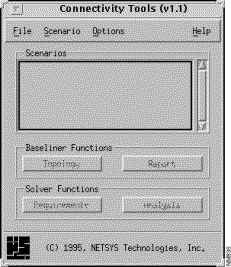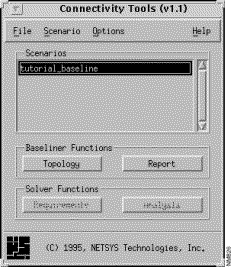|
|

The Connectivity Baseliner creates a baseline model of a network. This baseline is not editable but can be used to view information pertaining to a network's router and end system parameter settings. The baseline is constructed from Cisco® router configuration files. The router configuration files are parsed to extract network connectivity information. Statistics about router command usage are gathered and syntactic and semantic checks are performed.
See the following chapters for the following information:
The Connectivity Baseliner provides the following functionality:
Following are the recommended sequence of steps for using the Connectivity Baseliner to its fullest extent:
Step 1 Retrieve your network's router configuration files.
Step 2 Start the Connectivity Baseliner ($ECSP_HOME/ctk).
Step 3 Create a new baseline or open an existing baseline.
Step 4 Display the baseline's topology.
Step 5 Generate a diagnostic report about the baseline.
Step 6 Analyze the baseline's diagnostic report.
Step 7 Fix the baseline model problems reported in the diagnostic report.
Step 8 Regenerate the diagnostic report to ensure the problems have been resolved.
Step 9 If desired, view the baseline's router, LAN, end system, and link parameter settings.
Step 10 If desired, view the baseline's static routes, default networks, and routing algorithm parameter settings.
Prior to starting the Connectivity Baseliner, the environment variables described in the Enterprise/Solver Connectivity Tools READ THIS FIRST must be set properly. To display the current environment variable settings, enter the following command from the command line:
|
|
where:
-home dir_name is used to override the Connectivity Baseliner installation directory specified by the ECSP_HOME environment variable.
-data data_dir is used to override the data directory specified by the ECSP_DATA environment variable.
-editor editor is used to override the editor specified by the EDITOR environment variable.
-helpviewer help_viewer is used to override the help viewer specified by the ECSP_HELPVIEWER environment variable.
-help help_dir is used to override the help index directory specified by the ECSP_HELP environment variable.
Xt_options all Xt command line options are also supported. Use the xman -help command for details about these options.
Upon starting the Connectivity Baseliner, various checks are performed to ensure the required environment variables are set, commands used by the Connectivity Baseliner are accessible, and support files are available. While the checks are being performed, informational messages are displayed on the screen, as shown below. If a problem is detected, the process is aborted.
Connectivity Tools v1.1
Copyright NETSYS Technologies, Inc. 1995
----------------------------------------
Starting up in BASELINER mode.
Checking for `ECSP_HOME'... using /home/ecsp
Checking for `ECSP_DATA'... using /ecsp/newdata/gbrown
Checking for `EDITOR'... using vi
Checking for `ECSP_HELPVIEWER'... using /usr/local/bin/mosaic
Checking for `ECSP_BACKEND'... (not found) using netsys9
Checking for `vi'... using /usr/bin/vi
Checking for `xterm'... using /usr/openwin/bin/xterm
Checking for `rm'... using rm: aliased to rm -i
Checking for `cp'... using cp:aliased to cp -i
Checking for `tar'... using /usr/bin/tar
Checking for 'hostid'... using /usr/ucb/hostid
Checking for `sccs'... using /usr/ccs/bin/sccs
Checking for `admin'... using /usr/ccs/bin/admin
Checking for `delta'... using /usr/ccs/bin/delta
Checking for `prt'... using /usr/ccs/bin/prt
Checking for `prs'... using /usr/ccs/bin/prs
Checking for `get'... using /usr/ccs/bin/get
Checking for `unget'... using /usr/ccs/bin/unget
Checking for `delta'... using /usr/ccs/bin/delta
Checking for `val'... using /usr/ccs/bin/val
Checking for `mosaic'... using /usr/local/bin/mosaic
Checking for Connectivity Tools support files... OK
|
Upon starting the Connectivity Baseliner, the Connectivity Tools window, shown in Figure 2-1, is displayed.
The Connectivity Tools window contains the following components:
Topology) and generate, format, and display a baseline's Diagnostic Report (Report).
Until a new baseline is created or an existing baseline opened, the menu options applying to existing baselines and baseline scenarios, as well as the Topology, Report, Requirements, and Analysis buttons are inactive. Upon opening a baseline, most menu options and the Topology and Report buttons are activated.
The Connectivity Tools window components are discussed in the following subsections.
Select this option to load an existing baseline and create the baseline scenario. Upon selecting this option, the Open Baseline window is displayed. Specify the path to the directory containing existing baselines, select an existing baseline from the Baselines list, then click on the OK button to load the selected baseline. See "Open Baseline Window" in Chapter 3 for detailed information about the Open Baseline window components.
Upon returning from loading a baseline and creating the initial baseline scenario, the updated Connectivity Tools window, shown in Figure 2-2, is displayed.
TheConnectivity Tools window's Topology and Report buttons are now active enabling:
For information about these options, see the corresponding sections later in this chapter.
Select this option to create a new baseline. Upon selecting this option, the New Baseline window is displayed. Specify the name of the new baseline, the directory where the router configuration files used to create the new baseline are located, and the directory where the baseline files are to be placed, then click on the OK button. See "New Baseline Window" for detailed information about the New Baseline window components.
Select this option to delete an existing baseline. Upon selecting this option, the Delete Baseline window is displayed. You are not able to delete the currently loaded baseline. See "Delete Baseline Window" in Chapter 3 for detailed information about the Delete Baseline window components.
Select this option to save the baseline router configuration files to the specified directory. This feature is useful when the router configuration files have been modified. The modified router configuration files can then be used in another program or with routers in a work environment. Upon selecting this option, the Export Baseline window is displayed. See "Export Baseline Window" in Chapter 3 for detailed information about the Export Baseline window components.
Select this option to terminate the Connectivity Baseliner and save the current baseline. If any baseline router configuration files are being edited, the option of aborting all changes to the file(s) prior to exiting, is provided. The termination process can also be aborted and the changes to the baseline configuration files committed before electing to exit the Connectivity Baseliner.
This feature is not available with the Connectivity Baseliner. See "Create New" in Chapter 6 for detailed information about the functionality provided by the Scenario>Create New option in the Connectivity Solver.
This feature is not available with the Connectivity Baseliner. See "Rename" in Chapter 6 for detailed information about the functionality provided by the Connectivity Solver's Scenario>Rename option.
This feature is not available with the Connectivity Baseliner. See "Configuration Changes Window Components" in Chapter 7 for information about the functionality provided by the Connectivity Solver's Scenario>Configuration Changes option.
Select this option to open all iconified windows associated with this scenario.
Select this option to close all windows associated with this scenario to icons.
The Options menu contains the Find Device and Show Clipboard options.
Select this option to display the Find Device window. Specify a query mode, search pattern and network element type(s) to be searched for. Searching for routing table entries is not supported by the Connectivity Baseliner. See "Find Device Window Components" in Chapter 3 for a description of the Find Device window components.
Select this option to display the Clipboard window. The clipboard feature is a mechanism allowing you to aggregate various network elements. The collection of these elements can then be used in a variety of ways, such as input to batch processing and as a placeholder for the result of searches. See "Clipboard Window Components" in Chapter 3 for a description of the Clipboard window components.
Select a Help menu option to have the available on-line information about that subject displayed via the Mosaic or Netscape HTML browser specified by the ECSP_HELPVIEWER environment variable.
The Scenarios pane displays the initial baseline scenario. This pane is empty until a baseline is loaded, at which point a scenario, named after the current baseline, is created. For the Connectivity Baseliner, this is the only scenario that will be displayed, as the ability to create new scenarios, create and view network connectivity requirements, and create "what-if" scenario simulations are features provided by the Connectivity Solver.
The Connectivity Baseliner allows the current baseline scenario's topology layout, via the Topology button, and the Diagnostic Report created for the current baseline, via the Report button, to be displayed. The ability to view, create, and modify network connectivity requirements via the Requirements button is not available with the Connectivity Baseliner. Also not available with the Connectivity Baseliner is the ability to analyze "what-if" scenarios and connectivity requirements via the Analysis button. The Connectivity Solver provides these capabilities. See "Connectivity Solver" for detailed information about the additional capabilities provided with the Connectivity Solver.
Select a scenario entry in the Scenarios list, then click on this button to display its topology in the Topology window. See "Creating the Topology" for detailed information about creating a baseline topology and a description of the Topology window components.
Click on this button to generate a Diagnostic Report pertaining to the current baseline and have it formatted and displayed in a Diagnostic Report window. See "Diagnostic Report" for detailed information about creating Diagnostic Reports and a description of the Diagnostic Report window components.
This feature is not available with the Connectivity Baseliner. See "Requirements Button" in Chapter 6 for detailed information about the functionality provided by the Requirements button in the Connectivity Solver.
This feature is not available with the Connectivity Baseliner. See "Analysis Button" in Chapter 6 for detailed information about the functionality provided by the Analysis button in the Connectivity Solver.
|
|